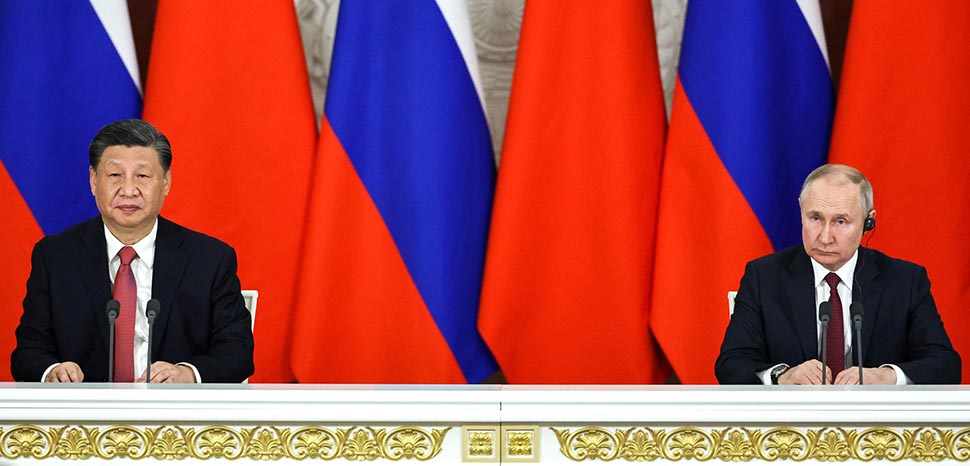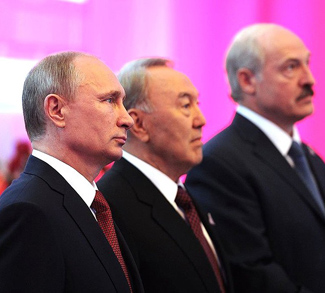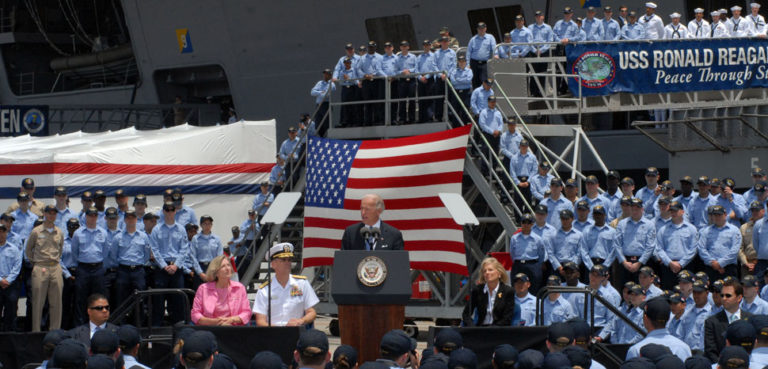The latter half of the 20th century was characterized by a lengthy ideological and geopolitical contention often referred to as the Cold War. The globe was practically divided into two spheres of influence, with the United States steering the Western Bloc and the Soviet Union heading the Eastern Bloc. This battle for dominance was not waged via direct military skirmishes, but rather through proxy conflicts, space races, nuclear brinkmanship, economic assistance programs, and ideological warfare.
Leap forward to today, and the reverberations of the Cold War seem to echo once more. Yet the geopolitical environment has experienced substantial shifts since the Soviet Union’s dissolution. We currently reside in a multipolar world where authority is distributed among several key players, including but not limited to the United States, China, Russia, and a consortium of European powers.
A meticulous assessment of the present global landscape exposes delicate but firm indicators that the world is gradually gravitating towards a new version of the Cold War. Nonetheless, the emerging geopolitical arrangement is significantly more complex and multifarious. Each power is actively participating in global politics, tactically placing their assets on the international chessboard to gain the best possible advantages.
The United States, while remaining a dominant global actor, encounters challenges to its hegemony from rising powers. China, bolstered by its swift economic development and expanding military capabilities, has surfaced as a substantial challenger in the global arena. Russia, despite facing numerous internal and external difficulties, maintains its global relevance. In parallel, the European powers, each grappling with distinct challenges, collectively exercise considerable clout in international political and economic forums.
These principal actors are earnestly strengthening alliances and reinforcing their global sway. Recent diplomatic initiatives and strategic advances demonstrate a readiness for a potential new Cold War. For instance, the United States’ interaction with New Zealand regarding the AUKUS agreement, China’s engagement with Russia in the face of the Ukraine war, and the diverse approaches of European powers towards China all suggest a strategic rearrangement evocative of Cold War dynamics.
However, the possibility of a new Cold War does not simply mirror the 20th-century version. The game’s rules have evolved, the players have expanded, and the stakes have indisputably risen. A thorough comprehension of these changes is vital for forecasting future international political trends and formulating strategies to efficiently traverse this shifting terrain. The complexities of the impending new Cold War, guided by these recent developments, will be the central point of the following analysis.
The United States: Restructuring Global Strategy in Evolving Circumstances
As the geopolitical terrain undergoes significant transformations, the United States is in a critical stage of reassessment and reinvention of its international strategy. The formulation of this complex strategy is influenced by the rise of new global actors, shifting allegiances, and the revival of traditional foes.
The shadows of past confrontations are evident in today’s geopolitics. A clear instance is the recent tension with Russia, wherein the United States and its allies were accused by the Kremlin of imposing “unprecedented pressure” on African countries. This event underscores the longstanding geopolitical rivalry between the two nations, evoking the dynamics of the Cold War era.
Moreover, the security concerns brought about by North Korea add another layer of complexity. The trial of the Hwasong-18 ICBM, a missile capable of reaching the United States, represents a serious threat to international security. This instance highlights the high stakes involved, reminding us that geopolitical strategy is not just about power demonstration but also about securing national and global safety.
In light of these challenges, the United States is adjusting its strategy and taking proactive steps on the international scene. A case in point is the country’s involvement with New Zealand concerning the AUKUS pact, a trilateral security alliance with the UK and Australia. This initiative underscores the United States’ intention to fortify its alliances in the Asia-Pacific area and counteract China’s growing influence.
Furthermore, the United States is widening its strategic attention to include regions such as the Pacific Islands. The recent interactions between Secretary Blinken and President Biden with leaders of the Pacific Islands showcase a renewed commitment to these nations. These endeavors reveal that every region holds importance in the United States’ comprehensive strategy.
In the evolving geopolitical scenario resembling a new Cold War, the United States is diligently strengthening its alliances, opposing its adversaries, and cultivating new partnerships. This multifaceted approach exemplifies the United States’ efforts to retain its global leadership position amidst rapidly shifting international dynamics. It’s a precise balancing act, laden with challenges and opportunities, that will steer the course of global politics in the 21st century.
China: An Emerging Superpower
China’s swift ascent to international prominence marks a pivotal episode in the chronicles of world history. Its impressive economic expansion, advanced technological developments, and significant military growth have pushed it to a prominent position in international politics. In the context of the nascent new Cold War, China is no mere bystander but a powerful player, actively drawing new partners and allies into its domain of influence.
One cannot discuss China’s international strategy without addressing its ambitious Belt and Road Initiative. This expansive project, evocative of the ancient Silk Road, seeks to establish a network of trade and infrastructure that extends across continents. Yet, despite the economic prospects it offers, the initiative has triggered apprehensions about debt-trap diplomacy and transparency deficits, thus portraying a multifaceted image of China’s international ambitions.
Recent events offer insights into China’s strategic actions. China’s alignment with Russia amidst the Ukraine war serves as an indicator of its geopolitical affiliations. Beijing’s unwavering support for Moscow, as shown by President Xi’s deepening ties with President Putin and echoing the Kremlin’s narrative over the conflict, signifies a strategic alliance that could substantially influence the dynamics of the new Cold War.
In the Pacific region, China’s increasing influence has raised alarms among established powers such as the United States and Australia. The conclusion of a security agreement with the Solomon Islands, Beijing’s regional investments, and the potential for a policing accord have escalated concerns about China’s aspirations. As US Secretary of State Antony Blinken flagged China’s “problematic behavior,” it’s evident that the Pacific is surfacing as a new battleground in the international power contest.
Further afield, China’s prospective plans for overseas naval bases in Asia and Africa denote its desire to safeguard shipping routes and enhance its capacity to withstand sanctions. Analysts propose that locations like the Hambantota port in Sri Lanka and the Ream naval base in Cambodia could be part of China’s plan to bolster its naval prowess. These developments highlight China’s strategic ambitions and the measures it is prepared to undertake to defend its interests.
In the global politics’ vast chessboard, China has transformed from a mere pawn to a potent player. As it continues to integrate new partners into its domain of influence and extends its global presence, the world watches with anxious anticipation. The ascent of the Dragon carries substantial consequences for the international order, infusing another layer of complexity to the budding new Cold War. However, akin to any other power, China’s rise is not free from obstacles, and only the passage of time will unveil how this elaborate game evolves.
Russia: Resurgent and Assertive
In the throes of a geopolitical realignment mirroring the Cold War period, Russia is rising as a bold actor maneuvering deftly amidst economic hardships and escalating geopolitical trials. Its capacity to preserve and augment its global sway reflects a strategic approach, as evidenced by recent occurrences that depict the portrait of a nation determined to affirm its stature and broaden its influence.
The Russia-Africa Economic and Humanitarian Forum convened in St. Petersburg serves as a symbolic representation of Russia’s tactical engagement with nations outside its immediate periphery. This occasion illuminated Russia’s desire to reinforce alliances with African nations, emphasizing its soft power endeavors and economic aspirations. However, the event’s achievements were somewhat marred by Russia’s sudden retreat from the Black Sea grain deal, an action that incited global anxiety regarding the stability of international food supplies, specifically in grain-reliant regions of Africa. Despite these obstacles, the summit accentuated Russia’s steadfast attempts to elevate its global rank.
Indisputably, the most critical and far-reaching event highlighting Russia’s assertiveness is the ongoing invasion of Ukraine, initiated in February 2022. This confrontation, which has transmuted into a significant geopolitical crisis, has propelled Russia into the international spotlight. The consequences of Russia’s actions in Ukraine resonate beyond the immediate area, inciting a substantial rearrangement of worldwide alliances and connections. As the world contends with the fallout of this dispute, Russia’s role and conduct are subjected to rigorous analysis.
Concurrently, the intensifying bond between President Xi Jinping of China and President Vladimir Putin of Russia illustrates a striking shift in global alignments. Their united front on the Ukraine issue indicates a potential strategic partnership that could significantly alter the dynamics of the nascent new Cold War.
In addition, Russia’s ongoing military and diplomatic interactions in regions like Africa and the Korean Peninsula highlight its plan to extend its sphere of influence. Military engagement in several African nations, lucrative arms transactions, and unwavering support for North Korea are all strategic moves aimed at solidifying Russia’s global presence. The potential establishment of naval bases in Asia and Africa provides further proof of Russia’s ambition to project power well beyond its territorial boundaries.
In the swiftly transforming arena of international politics, Russia has reasserted itself as a steadfast actor, relentless in its efforts to carve out a notable role. Amid increasing global pressure, the durability of Russia’s strategy will undeniably be a key factor in determining its position in this forthcoming new Cold War period. As we continue to monitor these evolving events, one fact remains evident: Russia’s current actions will significantly influence the geopolitical layout of the future.
The European Powers: Navigating Shifting Alliances
In the evolving stratagem of the incipient new Cold War, nations of Europe occupy a distinctive position, balancing delicately between historical affiliations and current realities. Each of these countries, as well as the collective European Union, are navigating actively through the novel geopolitical terrain. They are consolidating alliances and partnerships while concurrently addressing internal issues such as Brexit and the upswing of nationalism. Europe’s stance is particularly intricate due to its longstanding ties with the United States, geographical closeness to Russia, and growing economic interdependence with China.
Current events illuminate the diverse approaches pursued by different European powers. France, under President Macron’s leadership, has been expanding its geopolitical influence actively. Macron’s trip to Beijing, in the company of over 50 business representatives, culminated in new contracts for Airbus, EDF, and L’ Oréal, among others. This move, much to the displeasure of China skeptics in Europe and the United States, underlines France’s intent to nurture economic relationships with China.
Simultaneously, France is also affirming its influence in the Pacific, a region experiencing growing rivalry between China and the United States. Macron’s visit to an independent Pacific nation—the first by an incumbent French leader—was intended to emphasize France’s significance in the area. France’s rejuvenated focus on the Pacific and its proposition of an “alternative” in the region could considerably shape the dynamics of the imminent new Cold War.
Germany, under Chancellor Olaf Scholz, has also indicated a pragmatic attitude towards China. Scholz’s remarks on de-risking echoed those of Chinese Premier Li Qiang, demonstrating a cautious yet cooperative posture towards economic engagement with China.
Conversely, countries such as Lithuania, Poland, Romania, and the Czech Republic have taken a more contentious stance towards Beijing. Lithuania’s decision to permit Taiwan to establish a representative office in Vilnius, bans on Huawei by Poland and Romania, and the direct conversation between the newly elected Czech President Petr Pavel and the Taiwanese president underscore the diverging approaches within Europe.
These occurrences expose a complex and multifaceted European strategy in response to the imminent new Cold War. The varied approaches mirror the unique challenges and factors each country grapples with in this transforming geopolitical environment. It’s evident that European powers, both individually and as a collective, will persist in playing a significant role in defining the framework of this new global arrangement.
The Intricacies of the Emerging New Cold War
In the realm of global politics, a new narrative is emerging that bears striking parallels to a well-known historical period—the Cold War. However, despite similarities in the cast and overarching themes, the storyline of this renewed Cold War is distinct. The demarcation lines that once differentiated East from West are not as definitive, the links of economic interconnectedness are more potent and intricate, and the scene is no longer solely occupied by state actors.
This refreshed narrative signifies that the ideological discord is not simply a matter of capitalism against communism. It now encompasses a wider array of subjects including political governance, human rights, technology, and environmental change. It represents a multi-faceted ideological conflict that surpasses conventional political borders.
Moreover, the complex network of economic interconnectedness further distinguishes this looming Cold War from its forerunner. During the bipolar world of the 20th century, economic structures predominantly aligned with political alliances. Currently, global supply chains and financial systems traverse political and ideological divisions, forging a convoluted terrain of economic cooperation and rivalry.
Furthermore, the emergence of non-state actors—from multinational corporations and international organizations to cybercriminals and terror groups—adds an additional layer of intricacy. Empowered by technological advancements and globalization, these actors have the potential to shape global politics in ways that were inconceivable during the original Cold War.
However, as the world catapults into this new Cold War epoch, some elements of the historical playbook endure. The scramble of global powers to solidify their alliances and demarcate their spheres of influence harks back to former Cold War dynamics. Recent occurrences, such as the escalating assertiveness of Russia, China’s ambitious Belt and Road Initiative, and the tactical maneuverings of the United States and European powers, affirm this tendency.
Additionally, the 70th commemoration of the conclusion of the Korean War (1950-1953), one of the initial international conflicts of the Cold War era, provides a poignant reminiscence of the historical background and potential consequences of this novel geopolitical rivalry.
In this incipient new Cold War, the demarcations are more nebulous, the stakes are escalated, and the dynamics are more complicated. As leading powers hasten to construct new boundaries and pull new allies into their spheres, the world is positioned at a pivotal crossroad. Decisions taken now will delineate the trajectory of global politics for the ensuing decades.




